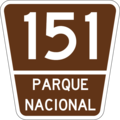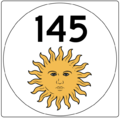National Highway System of Nouvelle Alexandrie: Difference between revisions
No edit summary |
|||
| Line 62: | Line 62: | ||
[[Category:Economy of Alduria-Wechua]] | [[Category:Economy of Alduria-Wechua]] | ||
[[Category:Geography of Alduria-Wechua]] | [[Category:Geography of Alduria-Wechua]] | ||
[[Category:Transportation]] | |||
Revision as of 10:20, 15 August 2020
The National Highway System of Alduria-Wechua is a federal designation for a transport network of highways and freeways that cross the Alduro-Wechua Federation, covering the Federation's Euran and Keltian territories. The system includes the Pan-Keltian Highway (road and marine), the Aldurian section of the Pan-Euran Highway, and the Trans-Aldurian Highway. Parts of the Wechua Royal Roads are part of the National Highway System, limited mainly to roads deemed essential to the defense, economy, and mobility of the country. The National Highway System is the road transportation backbone of the country. It is used by millions daily for their commutes, long-distance travel, and freight transport.
The federal government of Alduria-Wechua maintains little power or authority over the maintenance of the system, except for sharing part of the cost of economically significant projects and the cost of dedicated maintenance of the system. Decisions on expansions and maintenance rest largely on the regional governments. Dedicated revenue for the maintenance and expansion of the highways comes from a federal excise tax on gasoline. Regional governments normally dedicate the receipts from vehicle registration fees to maintaining the portions of the National Highway System under its jurisdiction. Portions of the National Highway System are toll roads, which include current and future high-occupancy toll (HOV[1].) lanes, express toll lanes, and hybrid systems.
Federal funding and oversight over the highways are done by the Department of Civil Works and Transportation (DCWT). Regional funding and oversight are usually carried out by a Cabinet department, usually Transportation.
The National Highway System is divided into four networks: primary, urban primary, secondary or inter-regional, and tertiary or local.
Highway Markers
| Highway type/network | Highway marker | Purpose | Route numbers |
|---|---|---|---|
| Primary roads | 
|
Facilitate movement of passengers and freight between regions. | 1–99[2] |
| Urban primary roads | 
|
Complement the primary network inside a metropolitan area or conurbation. | Any (1–9999) |
| Secondary (or inter-regional) roads | 
|
Provide access to rural or remote areas from primary network roads. | 100–299 |
| Tertiary (or intra-municipal) roads | 
|
Provide access to a municipality's main urban area from peripheral communities. | 300–9999 |
Less common markers
At least one other marker can be observed in Alduro-Wechua roads today. It is a marker used on roads through national and regional parks, is the brown-colored upside-down trapezoidal marker with the road number on the top two-thirds of the sign and the words National Park in its respective local language on the bottom one-third.
Marker used for roads that are part of the Qhapaq Ñan.
List of federal highways
- Pan-Keltian Highway (road and marine);
- Aldurian section of the Pan-Euran Highway;
- Trans-Aldurian Highway;
- Parts of the Wechua Royal Roads;
- Wechu Whoa
- Wechu Wi
- Wechu Three
See also
- ^ HOV = high occupancy vehicle
- ^ Just like some highways numbered 1–99 may have secondary or tertiary network type markers on specific segments of their roadways, some highways numbered 100–299 may have tertiary network markers—black numbers on white circles set against a black square—in specific segments of those highways as well to indicate that such portions of the highway are part of the tertiary network.

